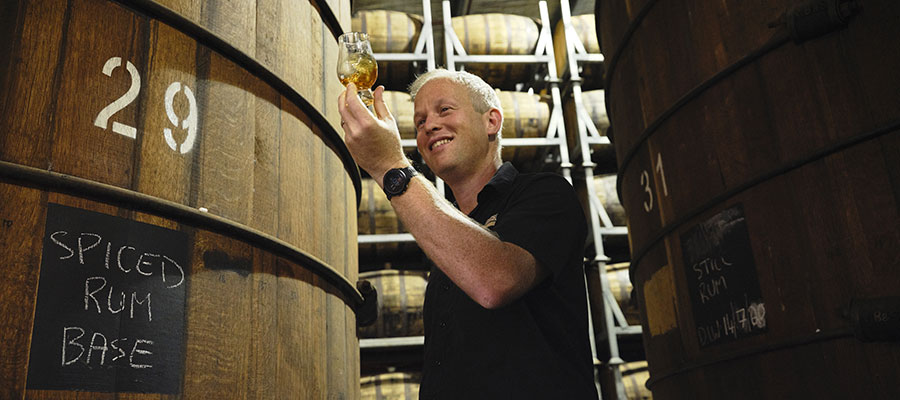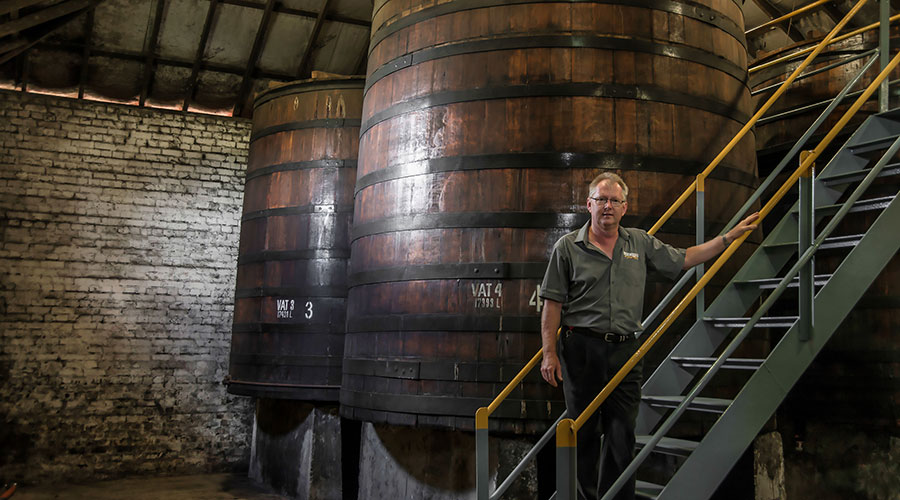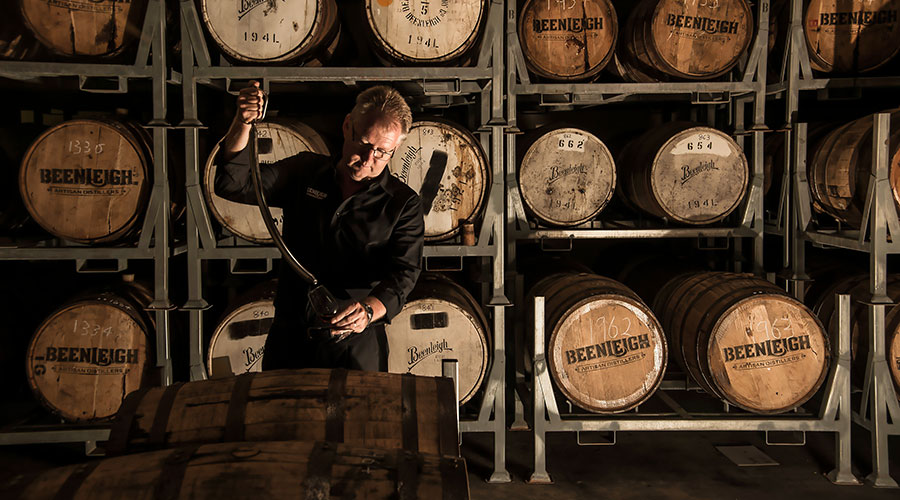Interview with Steven Magarry, group distiller for the Australian rum Beenleigh.

Rumporter : First rigorous question, what is your excuse for preferring American submarines to French ones?
Steven Magarry : (Laughs) We have nothing to do with this story! And we prefer our Navy Rum to these political stories…
Rumporter : A more general (real) question then. How do Australians perceive the French?
SM : Good food, good wine, good restaurants… are very much associated with French culture here. In fact, I had the chance to experience this when I came to France and it’s all true!
Rumporter : And French rum, have you ever tried it?
SM : Not enough for my taste! It was rather agricole rums from Martinique and Guadeloupe, and also rums from Polynesia and New Caledonia, which are closer to us geographically. But here, we have more of an English type of rum culture, so agricole rums seem very different to us.
For a majority of Australian consumers, they are used to molasses rums, it is a long learning process to get used to the typical aromas of agricole rums. But we do have a brand of pure cane juice rum in Australia: Husk (to which we have already given an article, ed. note). In any case, personally I like to discover all types of rums, I respect and appreciate them.
Rumporter : Let’s talk about your rums. Where does the molasses that you use as a base come from?
SM : It comes from three different places. The first is a 20-minute drive from the distillery. In fact, it’s been our main source of supply for over 100 years. But the demand for molasses has grown a lot in the last few years, so we source a little bit more from the north and also from the south. 100% of the molasses comes from Australia anyway.
It is interesting because we notice differences in the aromatic profiles of the white rums (new makes) according to the origin of the molasses. Even if these differences disappear with ageing and blending, they are very much appreciated by our distillation teams.
Rumporter : And what about the sugarcane, which varieties are used?
SM :We don’t use one in particular. There are about eight varieties that are grown for sugar and then used by the sugarcane industry, which then supplies us with our molasses.
It’s important to know that this industry is very important here as Australia produces more than 50,000 tons of molasses per year, making it the largest bulk sugar exporter in the world. But it is in high demand by other industries or for livestock feed and it is not always easy to get quality molasses, as there is not enough to go around and prices can vary greatly.
For example, the price of molasses has just doubled in two years, which can have an impact on our production.
Rumporter : What is the fermentation process at Beenleigh?
SM : Actually, seasonality, as well as the Australian climate, play a role. Rum production at Beenleigh started in 1884, so we have a long tradition behind us but our facilities are quite old. For example, our water tank, which we add to our molasses to ferment is on the roof (so it’s rainwater!).
In summer, the water temperature can rise to 30°C and in winter it can drop to 15°C. This will influence the fermentation time. In summer, it can be done very quickly in 28 or 30 hours. In the cooler months, from fall to spring, the fermentation process can take 4 or 5 days.
Knowing that we only use our own indigenous yeasts, which have also changed over the years with for example in the period of 2005-2010, we focused on recycling S. pombe and dunder.
However, from 2010 to today, our yeast profile has changed to a balance between alcohol character and operational efficiency.
Rumporter : What about the distillation ?
SM :The distillation process is quite unique as we use a column and a pot still. The molasses wine at 8% alcohol, called ‘wash’, goes through a column and runs at 60% ABV and then we run it through our copper pot still (which can hold 15,000 liters) and in the end the rum comes out at 88% ABV.
Here, our alcohol percentage of filling for maturation is 78.8%, a rather high maturation, but very traditional, due to the influence of a bit like the English Caribbean rums and Demerara rums. It’s part of the Beenleigh and Inner Circle trademark to have a high alcohol content when aging.
But we are currently experimenting with producing 60-66% rums in our sister distillery’s aging cellar in the desert. In any case, you could say that Beenleigh is both a column rum AND a still rum.
Rumporter : In what type of casks do you age your rums?
SM : Traditionally in Australia, we age our rums in large wooden vats that have previously held brandy. The Beenleigh distillery is the oldest facility in Australia and is a heritage site, so we have many old maturation vats that are treasures in the rum world!
These vats leave a very little mark on the rum (the oldest vats date back to the 1880s) and they can spend up to 15 years in them. All of our rums use both types of containers. In any case, all our rums spend at least two years in vats because it is the minimum legal age to market rum here in Australia.
After that, the rums can be transferred to smaller ex-bourbon barrels, which bring more color and aroma. But we also use casks that have previously held Australian port, wine casks…
Our maturing rum stocks are a “drop in the bucket” compared to our global rum family with Demerara Distillers, Appleton Estate, Mount Gay, Foursquare, Worthy Park and South Pacific Distilleries in Fiji.
Rumporter : So it is impossible to find a young Australian rum, that is to say, one that is less than two years old?
SM : Yes, Australia was a British colony and we based our rum on English practices in the 1880s when we started making rum here. There were several other rum distilleries already established in this region and the history of the rum industry in Australia goes back to the 1860s.
So we’re celebrating over 150 years of rum industry history, and over 137 of those years at Beenleigh… In fact, in the early 1900s, similar regulations were put in place for Australian whiskies, brandies and rums.
All three of these spirits had to be aged for at least two years. This was a protectionist measure against imported spirits, notably Jamaican rum exported to Europe and mixed with neutral alcohol for re-export to Australia (in the manner of Rum Verschnitt in Germany).
And also a measure to ensure the quality of Australian spirits, because at that time the Australian rum industry was very well established, over 50 years in business, and when we reflect on the production volumes of the time, they were very large, even by today’s modern standards.
And the custom of declaring a minimum age of two years has remained ever since. Yet, in today’s global rum industry, we must recognize that a balance is needed, perhaps a new classification of Australian rum as ageless that facilitates opportunities for innovation, experimentation and entrepreneurship.
We have a growing diversity of raw materials based on sugarcane juice or molasses, developments in bacterial and yeast fermentation, distillation technology options and a whole world of maturation possibilities. So why not embrace and champion these alternatives on the global rum scene?
Rumporter : Doesn’t it tickle your fancy to make young rums?
SM :It’s difficult to change. For example, the whisky industry is very attached to this two-year rule.
It’s kind of the same thing for the rum industry, even though there is now recognition of the quality of some unaged rums. Not to mention the fact that it would be an economic opportunity for the industry to have young rums, new makes to market.
In short, all of this means that we are thinking about it, that we could produce young rums to show what can be achieved but the rules are not going to change at the moment. We are, however, seeing a very small supply of unaged “white rums” coming in, but they are labeled as “cane spirit” because of the two-year maturation requirements for labeling and packaging of rum.
Our industry faces challenges, but creativity, innovation and world-class quality of liquids are the baseline for all Australian rum and sugarcane spirit producers.
Rumporter : What about Australian legislation on additives in rum?
SM : In Australia, the regulations, apart from the minimum ageing period of 2 years, are quite free. The majority of international rum distillers do not agree, but here you can make rum from granulated sugar, for example.
There are no regulations regarding the addition of sugar, flavoring or fruit to Australian rum. It will always be rum. As for Beenleigh rums, some have sugar added, some have spices added, some have nothing added.
In this case, what’s in the bottle is what came out of the still.
Rumporter : You supply rum to two of the three major Australian brands, Inner Circle and Beenleigh, do you have other customers outside Australia?
SM : In Europe, we supply rum to the broker E&A Scheer, to Main Rum Company, or to brands like Velier and Plantation, but we have also exported to the American markets.
In total, we have relationships with more than 20 independent bottlers, directly or indirectly. Inner Circle is our overproof rum portfolio and has a valuable heritage in the history of the Australian rum and sugar industry.
Navy Strength 57.2% ABV and Cask Strength 75.9% ABV have won international awards and received rave reviews from some of the industry’s biggest names.
We are fortunate to have La Maison & Velier as our distribution partner in the European Union and the United Kingdom for our Beenleigh and Inner Circle portfolio of rums, helping to put Australian rum on the world map.
Rumporter : Isn’t the competition against Bundaberg, a big group with a lot of money, while you are an independent distillery, too tough?
SM : In the last ten years, with the development of the internet, enthusiasts have been able to access much more diversity in rum and also much more information about the design of the products and the identity of the people who make them.
So they understand that Bundaberg’s (Diageo’s) strength is in volume while we focus on quality. In fact, few people know that Beenleigh and Inner Circle have won major trophies. Our production volumes can be a fraction of our family of rums, so the quality of the liquid is paramount!
Rumporter : What are your main markets and what new products do you offer in France?
SM :Our main markets are Australia, New Zealand, Singapore, the Middle East and more recently Europe. In France, you can find Plantation Rum 2007, TCRL 2015, Compagnie Des Indes – Australia, Duchess 2017 Beenleigh or Rum Explorer’s Origin Australia.
You also have access to Beenleigh Honey, Beenleigh Bourbon Barrel Aged, 5 Year Old, 10 Year Old, Inner Circle Navy Strength 57.2%, Inner Circle Cask Strength 75.9%. And at the end of this year comes our white rum, our 2016 vintage and our 2005 vintage in partnership with Velier!


